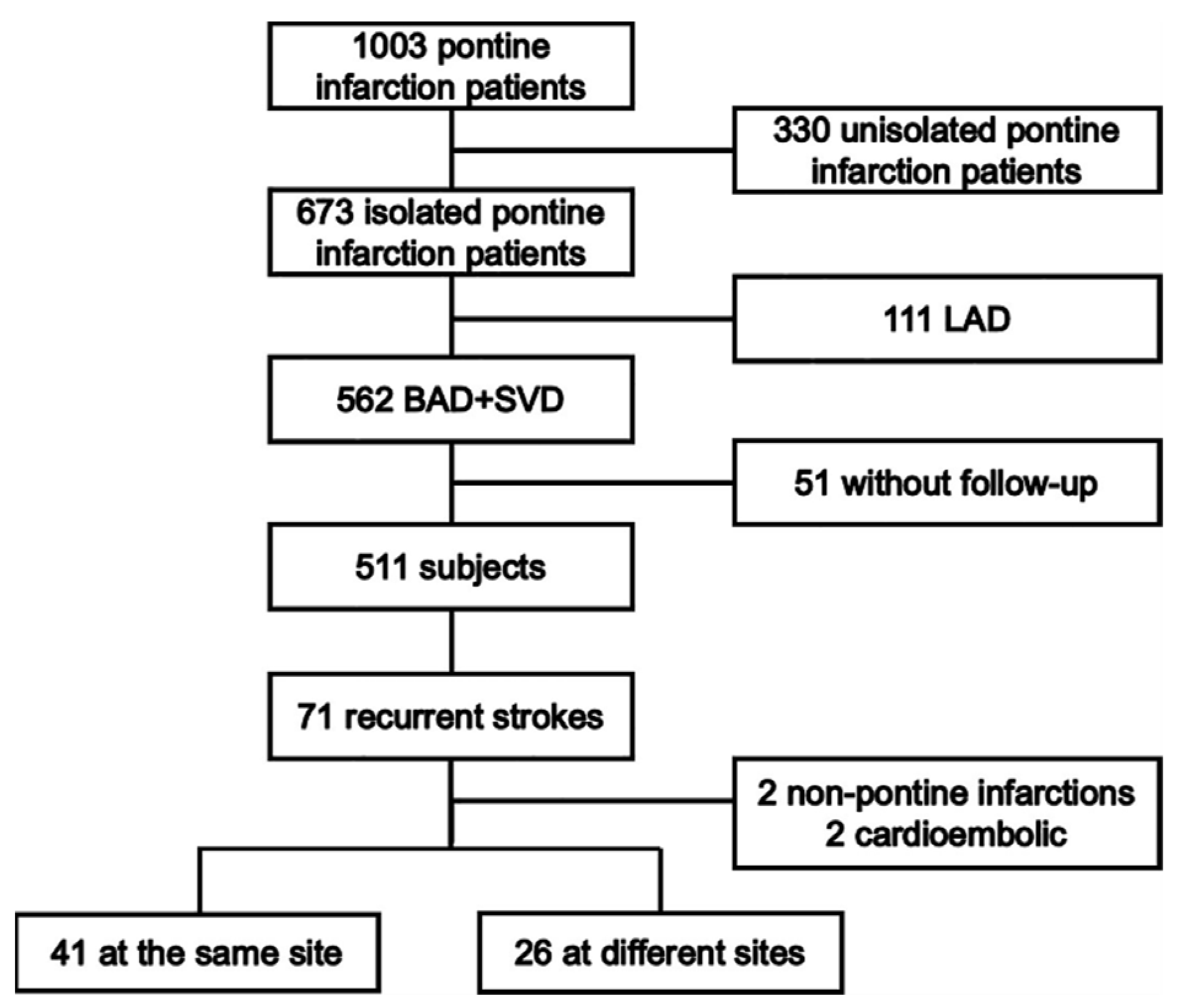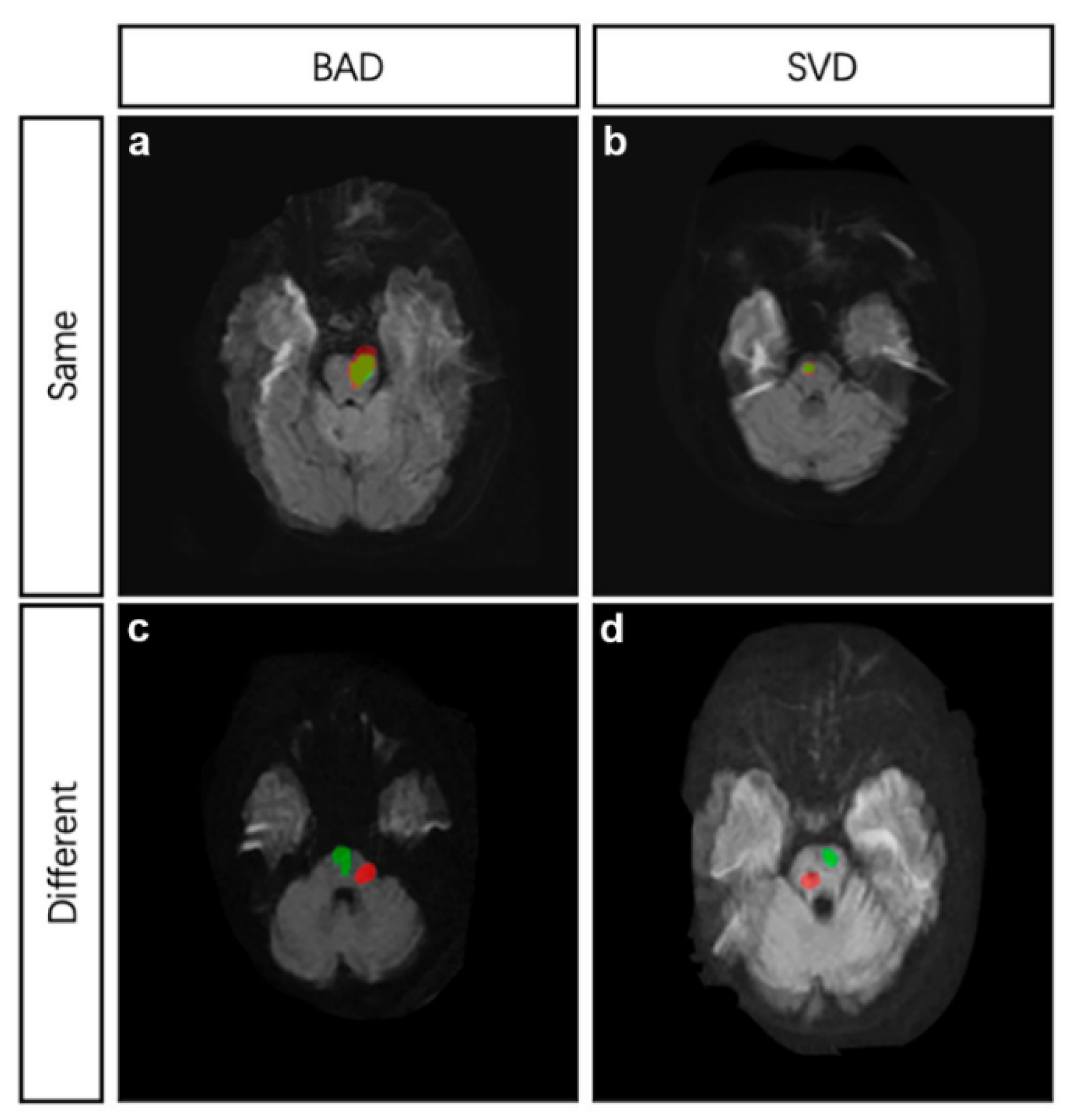Site and Mechanism of Recurrent Pontine Infarction: A Hospital-Based Follow-Up Study
Abstract
:1. Introduction
2. Materials and Methods
2.1. Study Design
2.2. Study Population
2.3. Demographic Characteristics
2.4. The Site and Mechanisms of Pontine Infarction
2.5. Statistical Analysis
3. Result
3.1. Participants
3.2. Mechanism of Index Pontine Infarction Associated with Site of Recurrence
3.3. Mechanism of Index Pontine Infarction Associated with Mechanism of Recurrence
4. Discussion
Author Contributions
Funding
Institutional Review Board Statement
Informed Consent Statement
Data Availability Statement
Conflicts of Interest
References
- Shin, D.H.; Lee, P.H.; Bang, O.Y. Mechanisms of recurrence in subtypes of ischemic stroke: A hospital-based follow-up study. Arch. Neurol. 2005, 62, 1232–1237. [Google Scholar] [CrossRef] [PubMed] [Green Version]
- Leung, T.W.; Wang, L.; Soo, Y.O.; Ip, V.H.; Chan, A.Y.; Au, L.W.; Fan, F.S.; Lau, A.Y.; Leung, H.; Abrigo, J.; et al. Evolution of intracranial atherosclerotic disease under modern medical therapy. Ann. Neurol. 2015, 77, 478–486. [Google Scholar] [CrossRef] [PubMed]
- Huang, R.; Zhang, X.; Chen, W.; Lin, J.; Chai, Z.; Yi, X. Stroke Subtypes and Topographic Locations Associated with Neurological Deterioration in Acute Isolated Pontine Infarction. J. Stroke Cerebrovasc. Dis. 2016, 25, 206–213. [Google Scholar] [CrossRef]
- Vemmos, K.N.; Spengos, K.; Tsivgoulis, G.; Manios, E.; Zis, V.; Vassilopoulos, D. Aetiopathogenesis and long-term outcome of isolated pontine infarcts. J. Neurol. 2005, 252, 212–217. [Google Scholar] [CrossRef]
- Huang, J.; Qiu, Z.; Zhou, P.; Li, J.; Chen, Y.; Huang, R.; Li, C.; Ouyang, X.; Feng, H.; Xu, H.; et al. Topographic location of unisolated pontine infarction. BMC Neurol. 2019, 19, 186. [Google Scholar] [CrossRef] [Green Version]
- Kumral, E.; Bayulkem, G.; Evyapan, D. Clinical spectrum of pontine infarction. Clinical-MRI correlations. J. Neurol. 2002, 249, 1659–1670. [Google Scholar] [CrossRef] [PubMed]
- Gökçal, E.; Niftaliyev, E.; Baran, G.; Deniz, Ç.; Asil, T. Progressive deficit in isolated pontine infarction: The association with etiological subtype, lesion topography and outcome. Acta Neurol. Belg. 2017, 117, 649–654. [Google Scholar] [CrossRef]
- Klein, I.F.; Lavallée, P.C.; Mazighi, M.; Schouman-Claeys, E.; Labreuche, J.; Amarenco, P. Basilar artery atherosclerotic plaques in paramedian and lacunar pontine infarctions: A high-resolution MRI study. Stroke 2010, 41, 1405–1409. [Google Scholar] [CrossRef] [Green Version]
- Frid, P.; Drake, M.; Giese, A.K.; Wasselius, J.; Schirmer, M.D.; Donahue, K.L.; Cloonan, L.; Irie, R.; Bouts, M.J.; McIntosh, E.C.; et al. Detailed phenotyping of posterior vs. anterior circulation ischemic stroke: A multi-center MRI study. J. Neurol. 2020, 267, 649–658. [Google Scholar] [CrossRef] [Green Version]
- Nadeau, S.; Jordan, J.; Mishra, S. Clinical presentation as a guide to early prognosis in vertebrobasilar stroke. Stroke 1992, 23, 165–170. [Google Scholar] [CrossRef] [Green Version]
- Zhang, M.; Lin, Q.; Lu, J.; Rong, D.; Zhao, Z.; Ma, Q.; Liu, H.; Shu, N.; He, Y.; Li, K. Pontine infarction: Diffusion-tensor imaging of motor pathways—A longitudinal study. Radiology 2015, 274, 841–850. [Google Scholar] [CrossRef] [PubMed]
- Ju, Y.; Hussain, M.; Asmaro, K.; Zhao, X.; Liu, L.; Li, J.; Wang, Y. Clinical and imaging characteristics of isolated pontine infarcts: A one-year follow-up study. Neurol. Res. 2013, 35, 498–504. [Google Scholar] [CrossRef] [PubMed]
- Fisher, C.M. The ‘herald hemiparesis’ of basilar artery occlusion. Arch. Neurol. 1988, 45, 1301–1303. [Google Scholar] [CrossRef] [PubMed]
- Zheng, D.; Zhu, M.; Shi, W.; Li, M.; Chen, W.; Dai, Q.; Jiang, Y.; Liu, X. The Incidence and Risk Factors of In-Stent Restenosis for Vertebrobasilar Artery Stenting. World Neurosurg. 2018, 110, e937–e941. [Google Scholar] [CrossRef]
- Boulanger, M.; Béjot, Y.; Rothwell, P.M.; Touzé, E. Long-Term Risk of Myocardial Infarction Compared to Recurrent Stroke After Transient Ischemic Attack and Ischemic Stroke: Systematic Review and Meta-Analysis. J. Am. Heart Assoc. 2018, 7, e007267. [Google Scholar] [CrossRef] [Green Version]
- Amarenco, P.; Lavallée, P.C.; Labreuche, J.; Albers, G.W.; Bornstein, N.M.; Canhão, P.; Caplan, L.R.; Donnan, G.A.; Ferro, J.M.; Hennerici, M.G.; et al. One-Year Risk of Stroke after Transient Ischemic Attack or Minor Stroke. N. Engl. J. Med. 2016, 374, 1533–1542. [Google Scholar] [CrossRef]
- Khanevski, A.N.; Bjerkreim, A.T.; Novotny, V.; Næss, H.; Thomassen, L.; Logallo, N.; Kvistad, C.E.; NOR-STROKE Study Group. Recurrent ischemic stroke: Incidence, predictors, and impact on mortality. Acta Neurol. Scand. 2019, 140, 3–8. [Google Scholar] [CrossRef] [Green Version]
- Kim, J.S. Recurrent pontine base infarction: A controlled study. Cerebrovasc. Dis. 2002, 13, 257–261. [Google Scholar] [CrossRef]
- Sangha, R.S.; Prabhakaran, S.; Feldmann, E.; Honda, T.; Nizam, A.; Cotsonis, G.A.; Campo-Bustillo, I.; Romano, J.G.; Liebeskind, D.S. Imaging Patterns of Recurrent Infarction in the Mechanisms of Early Recurrence in Intracranial Atherosclerotic Disease (MyRIAD) Study. Front. Neurol. 2020, 11, 615094. [Google Scholar] [CrossRef]
- Raghuram, K.; Durgam, A.; Kohlnhofer, J.; Singh, A. Relationship between stroke recurrence, infarct pattern, and vascular distribution in patients with symptomatic intracranial stenosis. J. Neurointerv. Surg. 2018, 10, 1161–1163. [Google Scholar] [CrossRef]
- López-Cancio, E.; Matheus, M.G.; Romano, J.G.; Liebeskind, D.S.; Prabhakaran, S.; Turan, T.N.; Cotsonis, G.A.; Lynn, M.J.; Rumboldt, Z.; et al.; Warfarin-Aspirin Symptomatic Intracranial Disease (WASID) trial investigators Infarct patterns, collaterals and likely causative mechanisms of stroke in symptomatic intracranial atherosclerosis. Cerebrovasc. Dis. 2014, 37, 417–422. [Google Scholar] [CrossRef] [PubMed] [Green Version]
- Regenhardt, R.W.; Das, A.S.; Ohtomo, R.; Lo, E.H.; Ayata, C.; Gurol, M.E. Pathophysiology of Lacunar Stroke: History’s Mysteries and Modern Interpretations. J. Stroke Cerebrovasc. Dis. 2019, 28, 2079–2097. [Google Scholar] [CrossRef] [PubMed]


| Site of Recurrence | Univariate Analysis | Multivariate Analysis | ||||||
|---|---|---|---|---|---|---|---|---|
| Same (n = 41) | Different (n = 26) | OR | p | 95% CI | OR | p | 95% CI | |
| Gender (male) | 28 (68.29%) | 15 (57.69%) | 1.579 | 0.379 | 0.570–4.375 | |||
| Age (years, m ± SD) | 66.17 ± 10.59 | 69.35 ± 8.52 | 0.966 | 0.202 | 0.916–1.019 | |||
| Smoker | 11 (26.83%) | 7 (26.92%) | 0.995 | 0.993 | 0.329–3.015 | |||
| Drinker | 6 (14.63%) | 3 (11.54%) | 1.314 | 0.718 | 0.298–5.787 | |||
| Hyperlipidemia | ||||||||
| TG | 17 (41.46%) | 7 (26.92%) | 1.923 | 0.230 | 0.662–5.584 | |||
| TC | 17 (41.46%) | 9 (34.62%) | 1.338 | 0.576 | 0.483–3.708 | |||
| LDL | 10 (24.39%) | 4 (15.38%) | 1.774 | 0.381 | 0.492–6.393 | |||
| Hypertension | 33 (80.49%) | 24 (92.31%) | 0.344 | 0.201 | 0.067–1.765 | |||
| Diabetes | 16 (39.02%) | 13 (50.00%) | 0.640 | 0.378 | 0.237–1.726 | |||
| Stroke History | 12 (29.27%) | 11 (42.31%) | 0.564 | 0.276 | 0.202–1.578 | |||
| Medications | ||||||||
| Antihypertensive | 19 (46.34%) | 17 (65.38%) | 0.457 | 0.131 | 0.166–1.261 | 0.493 | 0.186 | 0.173–1.405 |
| Hypoglycemic | 16 (39.02%) | 10 (38.46%) | 1.024 | 0.963 | 0.373–2.809 | |||
| Statins | 32 (78.05%) | 18 (69.23%) | 1.580 | 0.421 | 0.519–4.813 | |||
| Antiplatelet | 35 (85.37%) | 21 (80.77%) | 1.389 | 0.622 | 0.377–5.118 | |||
| Index stroke mechanism | 3.086 | 0.030 | 1.112–8.559 | 2.938 | 0.041 | 1.044–8.268 | ||
| BAD | 27 (65.85%) | 10 (38.46%) | ||||||
| SVD | 14 (34.15%) | 16 (61.54%) | ||||||
| Mechanism of Recurrence | Univariate Analysis | Multivariate Analysis | ||||||
|---|---|---|---|---|---|---|---|---|
| BAD (n = 42) | SVD (n = 25) | OR | p | 95% CI | OR | p | 95% CI | |
| Gender (male) | 27 (64.28%) | 16 (64.00%) | 1.012 | 0.981 | 0.361–2.842 | |||
| Age (years, m ± SD) | 66.47 ± 10.19 | 68.96 ± 9.37 | 0.974 | 0.320 | 0.924–1.026 | |||
| Smoker | 13 (30.95%) | 5 (20.00%) | 1.793 | 0.331 | 0.552–5.825 | |||
| Drinker | 7 (16.67%) | 2 (8.00%) | 2.300 | 0.325 | 0.439–12.062 | |||
| Hyperlipidemia | ||||||||
| TG | 17 (40.48%) | 7 (28.00%) | 1.749 | 0.305 | 0.061–2.090 | |||
| TC | 17 (40.48%) | 9 (36.00%) | 1.209 | 0.716 | 0.435–3.363 | |||
| LDL | 8 (19.05%) | 6 (2400%) | 0.745 | 0.630 | 0.225–2.469 | |||
| Hypertension | 38 (90.47%) | 19 (76.00%) | 3.000 | 0.119 | 0.755–11.922 | 6.010 | 0.038 | 1.100–32.850 |
| Diabetes | 21 (50.00%) | 8 (32.00%) | 2.125 | 0.154 | 0.755–5.984 | 2.297 | 0.193 | 0.657–8.030 |
| Stroke History | 14 (33.33%) | 9 (36.00%) | 0.889 | 0.824 | 0.315–2.511 | |||
| Medications | ||||||||
| Antihypertensive | 22 (52.38%) | 14 (56.00%) | 0.864 | 0.774 | 0.320–2.338 | |||
| Hypoglycemic | 18 (42.85%) | 8 (32.00%) | 1.594 | 0.379 | 0.564–4.505 | |||
| Statins | 31 (73.81%) | 19 (76.00%) | 0.890 | 0.842 | 0.283–2.802 | |||
| Antiplatelet | 36 (85.71%) | 20 (80.00%) | 1.500 | 0.543 | 0.406–5.541 | |||
| Index stroke mechanism | 6.429 | 0.001 | 2.140–19.316 | 6.056 | 0.004 | 1.774–20.679 | ||
| BAD | 30 (71.43%) | 7 (28.00%) | ||||||
| SVD | 12 (38.57%) | 18 (72.00%) | ||||||
| Site of recurrence | 3.182 | 0.028 | 1.130–8.960 | 3.710 | 0.045 | 1.030–13.364 | ||
| Same site | 30 (71.43%) | 11 (44.00%) | ||||||
| Different | 12 (38.57%) | 14 (56.00%) | ||||||
| Mechanism of Index Pontine Infarction | p | ||
|---|---|---|---|
| BAD | SVD | ||
| N | 37 | 30 | |
| Mechanism of recurrent pontine infarction located at the same site with index stroke | <0.05 | ||
| BAD | 26 | 4 | |
| SVD | 1 | 10 | |
| Mechanism of recurrent pontine infarction located at different sites with index stroke | <0.05 | ||
| BAD | 4 | 8 | |
| SVD | 6 | 8 | |
Publisher’s Note: MDPI stays neutral with regard to jurisdictional claims in published maps and institutional affiliations. |
© 2022 by the authors. Licensee MDPI, Basel, Switzerland. This article is an open access article distributed under the terms and conditions of the Creative Commons Attribution (CC BY) license (https://creativecommons.org/licenses/by/4.0/).
Share and Cite
Wu, L.; Li, Y.; Ye, Z.; Liu, D.; Dai, Z.; Zhu, J.; Chen, H.; Li, C.; Lie, C.; Jiang, Y. Site and Mechanism of Recurrent Pontine Infarction: A Hospital-Based Follow-Up Study. Brain Sci. 2022, 12, 520. https://doi.org/10.3390/brainsci12050520
Wu L, Li Y, Ye Z, Liu D, Dai Z, Zhu J, Chen H, Li C, Lie C, Jiang Y. Site and Mechanism of Recurrent Pontine Infarction: A Hospital-Based Follow-Up Study. Brain Sciences. 2022; 12(5):520. https://doi.org/10.3390/brainsci12050520
Chicago/Turabian StyleWu, Li, Youfu Li, Zeming Ye, Dezhi Liu, Zheng Dai, Juehua Zhu, Hongbing Chen, Chenghao Li, Chaowei Lie, and Yongjun Jiang. 2022. "Site and Mechanism of Recurrent Pontine Infarction: A Hospital-Based Follow-Up Study" Brain Sciences 12, no. 5: 520. https://doi.org/10.3390/brainsci12050520
APA StyleWu, L., Li, Y., Ye, Z., Liu, D., Dai, Z., Zhu, J., Chen, H., Li, C., Lie, C., & Jiang, Y. (2022). Site and Mechanism of Recurrent Pontine Infarction: A Hospital-Based Follow-Up Study. Brain Sciences, 12(5), 520. https://doi.org/10.3390/brainsci12050520





